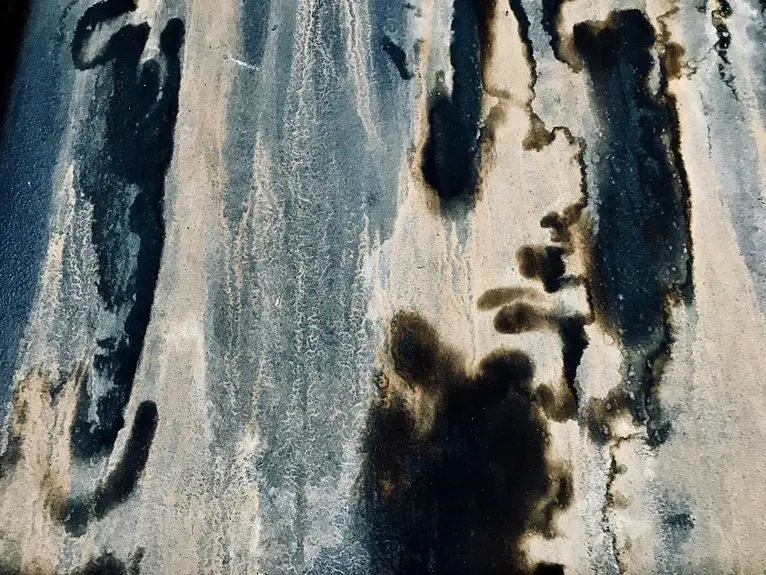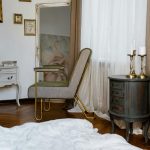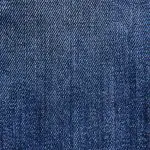To safely remove mold and mildew from upholstery, first wear gloves and a mask to protect yourself from spores. Vacuum the area to remove loose mold, then gently scrub with a mild detergent or a vinegar-water mix after testing it on a hidden spot. Blot with a damp cloth and dry thoroughly in a well-ventilated area. Keeping your furniture dry and ventilated helps prevent return growth. For deeper insights on cleaning and prevention, you’ll find more helpful tips ahead.
Table of Contents
Key Takeaways
- Wear gloves, a mask, and goggles to protect yourself from mold spores during cleaning.
- Vacuum the upholstery with a HEPA vacuum to remove loose mold spores before applying any cleaner.
- Use a mild detergent or a vinegar-water solution and test it on a hidden spot for colorfastness.
- Gently scrub moldy areas with a soft brush or cloth, then blot with a damp cloth and air dry.
- Keep upholstery dry and ventilated, and consider using a dehumidifier to prevent mold from returning.
Identifying Mold and Mildew on Upholstery
How can you tell if your upholstery has mold or mildew? First, look for visible signs like fuzzy or slimy patches that are white, green, black, or gray. These spots often appear in damp or poorly ventilated areas.
You might also notice a musty, earthy odor, which is a strong indicator that mold or mildew is present. Touch the fabric gently—if it feels damp or has a powdery texture, that’s another clue.
Pay attention to allergy symptoms like sneezing or itchy eyes when you’re near the furniture, as mold spores can trigger these reactions. Catching mold or mildew early helps prevent damage and health risks, so keep an eye out for these telltale signs on your upholstery.
Preparing Your Cleaning Supplies and Protective Gear
Gathering the right cleaning supplies and protective gear is essential before tackling mold and mildew on your upholstery.
Start by wearing gloves to protect your skin and a mask to avoid inhaling spores. Safety goggles can shield your eyes from irritants.
Next, prepare your cleaning materials: a soft brush or vacuum with a HEPA filter to remove loose spores, a spray bottle for applying cleaning solutions, and clean cloths for blotting.
Gather cleaning tools like a soft brush, HEPA vacuum, spray bottle, and cloths to tackle mold spores efficiently.
Use a mild detergent or a mixture of white vinegar and water—both effective yet gentle on fabric. Avoid harsh chemicals that might damage your upholstery.
Finally, guarantee good ventilation in your workspace by opening windows or using fans, which helps reduce airborne spores and speeds up drying after cleaning.
Step-by-Step Cleaning Process for Upholstery
Once you’ve prepared your supplies and protected yourself, you can start removing mold and mildew from your upholstery.
Begin by taking the following steps:
- Vacuum the affected area thoroughly to remove loose spores.
- Mix a cleaning solution suitable for your fabric type.
- Test the cleaner on a hidden spot to check for colorfastness.
- Gently scrub the moldy spots with a soft brush or cloth.
After scrubbing, blot the area with a clean, damp cloth to lift away residue.
Avoid saturating the fabric to prevent further damage.
Finally, allow your upholstery to dry completely in a well-ventilated space, ideally with sunlight, to inhibit mold regrowth.
Following these steps carefully will help restore your upholstery safely and effectively.
Natural Remedies vs. Commercial Cleaners: What Works Best?
You’ll want to weigh how well natural remedies stack up against commercial cleaners in removing mold and mildew.
Consider not only their effectiveness but also how safe they’re for you and your upholstery.
Plus, think about the environmental impact each option brings before making your choice.
Effectiveness Comparison
Two main approaches dominate mold and mildew removal from upholstery: natural remedies and commercial cleaners. You might wonder which one delivers better results.
Natural remedies like vinegar and baking soda are gentle and eco-friendly but might require repeated applications for stubborn mold. Commercial cleaners, on the other hand, often contain stronger antifungal agents that eliminate mold faster but can be harsher on fabrics.
Consider these points:
- Natural remedies are safer for delicate materials.
- Commercial cleaners work faster on heavy infestations.
- Natural methods may leave less residue or odor.
- Some commercial products offer specialized formulas for upholstery.
Ultimately, your choice depends on the severity of the mold and your upholstery type. Balancing effectiveness with fabric care guarantees the best outcome.
Safety Considerations
Choosing between natural remedies and commercial cleaners isn’t just about how well they remove mold—it’s also about how safe they’re for you and your upholstery.
Natural remedies like vinegar or baking soda tend to be gentler, reducing the risk of harsh chemical exposure or damaging delicate fabrics. They’re less likely to cause allergic reactions or irritate your skin and respiratory system. However, natural options may require more effort and repeated applications.
Commercial cleaners often contain stronger chemicals that work quickly but can pose health risks if inhaled or mishandled. You should always use gloves, guarantee proper ventilation, and follow instructions precisely.
Ultimately, consider your upholstery’s material and your sensitivity to chemicals when choosing the safest option for mold removal.
Environmental Impact
While natural remedies like vinegar and baking soda often take longer to work, they tend to have a much lower environmental impact compared to commercial cleaners.
When you choose natural options, you reduce your exposure to harsh chemicals that can harm aquatic life and pollute water systems.
Commercial cleaners, though effective, usually contain synthetic chemicals that persist in the environment and may contribute to air and water pollution.
Here’s what you should consider:
- Natural ingredients are biodegradable and less toxic.
- Commercial products often use non-renewable resources.
- Packaging waste from commercial cleaners can be significant.
- Natural remedies promote safer indoor air quality.
Preventing Mold and Mildew From Returning
Since mold and mildew thrive in damp environments, you’ll want to keep your upholstery dry and well-ventilated to prevent them from coming back.
Make sure to open windows or use fans to circulate air regularly. Avoid placing furniture too close to walls, which can trap moisture. If spills happen, clean and dry the area immediately to stop mold growth before it starts.
Using a dehumidifier in humid rooms can also help maintain a moisture-free environment. Additionally, consider applying a fabric protector that resists moisture and mold.
When to Seek Professional Upholstery Cleaning Services
Even with careful prevention, mold and mildew can sometimes take hold in ways that are tough to manage on your own.
You should consider professional upholstery cleaning services if the mold covers a large area, or if it keeps coming back despite your efforts.
Professionals have specialized tools and cleaning agents that can reach deep into the fabric and padding, ensuring thorough removal.
Also, if you notice a persistent musty odor or if you or your family experience allergic reactions, it’s time to call in experts.
Look for professional help when:
- Mold growth is extensive or embedded
- DIY cleaning doesn’t eliminate the smell
- You have allergies or respiratory issues
- Your upholstery is delicate or expensive
Trusting specialists can save your furniture and health.
Frequently Asked Questions
Can Mold on Upholstery Cause Health Problems?
Yes, mold on upholstery can cause health problems. If you’re sensitive or allergic, it might trigger respiratory issues, headaches, or skin irritation. You’ll want to address it promptly to protect your health and comfort.
How Long Does Mold Take to Develop on Fabric?
Mold doesn’t appear overnight; it takes about 24 to 48 hours in a damp, warm environment to quietly begin forming on fabric. If you don’t act quickly, it can become a persistent, unwelcome guest.
Is It Safe to Use Bleach on All Upholstery Types?
You shouldn’t use bleach on all upholstery types because it can damage fabrics and colors. Instead, test a small area first and consider gentler cleaners or professional help for delicate or non-colorfast materials to avoid ruining your furniture.
Can Mold Spores Spread to Other Areas During Cleaning?
Yes, mold spores can easily spread during cleaning if you’re not careful. You should contain the area, wear protective gear, and use gentle methods to prevent spreading spores to other surfaces or rooms in your home.
What Are the Signs of Mold Damage Beyond Visible Spots?
You’ll notice musty odors, fabric discoloration, and a damp feeling even where spots aren’t visible. Mold can also weaken fibers, causing your upholstery to feel brittle or crumbly in affected areas.
- Does Chiffon Fabric Stink - July 15, 2025
- Does Chiffon Fabric Affect the Economy - July 15, 2025
- Does Cotton Fabric Have a Nap - July 15, 2025






